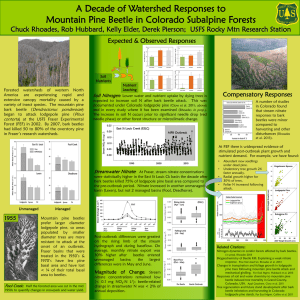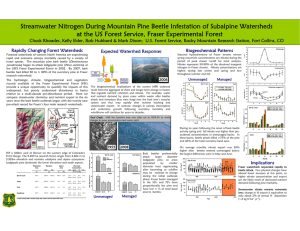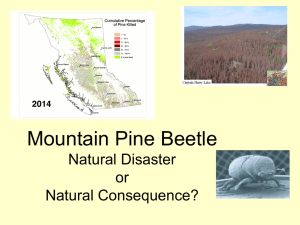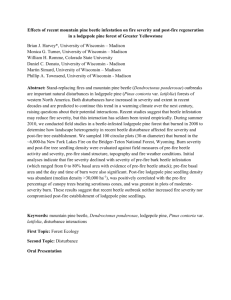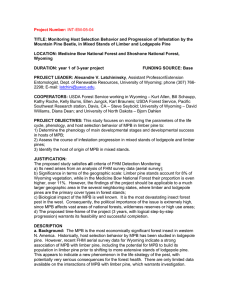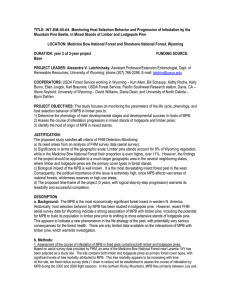Linking stream nitrate to forest response and recovery after severe...
advertisement
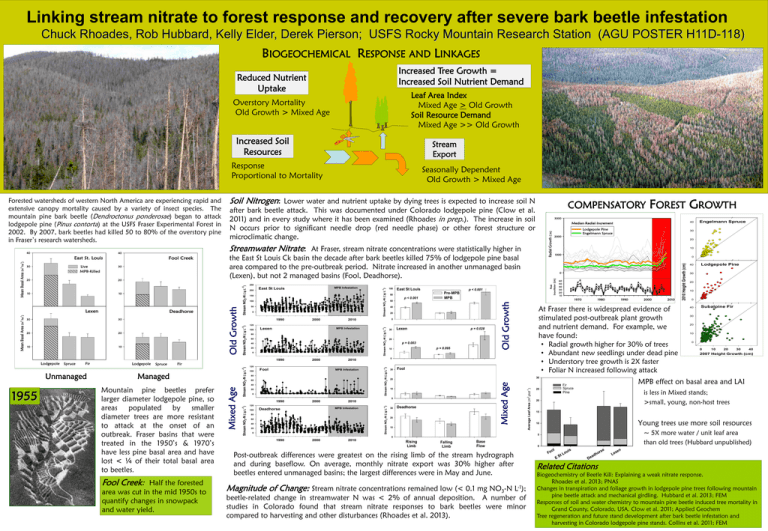
Linking stream nitrate to forest response and recovery after severe bark beetle infestation Chuck Rhoades, Rob Hubbard, Kelly Elder, Derek Pierson; USFS Rocky Mountain Research Station (AGU POSTER H11D-118) BIOGEOCHEMICAL RESPONSE AND LINKAGES Increased Tree Growth = Increased Soil Nutrient Demand Reduced Nutrient Uptake Leaf Area Index Mixed Age > Old Growth Soil Resource Demand Mixed Age >> Old Growth Overstory Mortality Old Growth > Mixed Age Increased Soil Resources Stream Export Response Proportional to Mortality 20 20 10 10 0 1990 1955 Spruce Fir Managed Mountain pine beetles prefer larger diameter lodgepole pine, so areas populated by smaller diameter trees are more resistant to attack at the onset of an outbreak. Fraser basins that were treated in the 1950’s & 1970’s have less pine basal area and have lost < ¼ of their total basal area to beetles. Fool Creek: Half the forested area was cut in the mid 1950s to quantify changes in snowpack and water yield. Stream NO3-N (g L-1) Unmanaged Lodgepole 100 Lexen 40 20 80 60 40 20 0 2000 100 Fool MPB Infestation 80 60 40 20 0 Lexen p = 0.028 20 p = 0.003 p = 0.095 10 30 10 2010 120 100 MPB Infestation Deadhorse 80 60 40 20 0 30 10 1000 0 1980 1990 Deadhorse 20 10 2000 2010 25 Falling Limb Base Flow Post-outbreak differences were greatest on the rising limb of the stream hydrograph and during baseflow. On average, monthly nitrate export was 30% higher after beetles entered unmanaged basins; the largest differences were in May and June. Magnitude of Change: Stream nitrate concentrations remained low (< 0.1 mg NO3-N L-1); beetle-related change in streamwater N was < 2% of annual deposition. A number of studies in Colorado found that stream nitrate responses to bark beetles were minor compared to harvesting and other disturbances (Rhoades et al. 2013). Lodgepole Pine 30 20 10 0 40 Subalpine Fir 30 20 10 0 0 10 20 30 40 2007 Height Growth (cm) is less in Mixed stands; >small, young, non-host trees 20 15 Young trees use more soil resources 10 ~ 5X more water / unit leaf area than old trees (Hubbard unpublished) 5 Rising Limb 2010 40 MPB effect on basal area and LAI Fir Spruce Pine 0 1990 2000 2010 Height Growth (cm) Radial Growth (m) 20 30 20 Engelmann Spruce 2000 Peak SnowWater (cm) Fool 0 2000 30 At Fraser there is widespread evidence of stimulated post-outbreak plant growth and nutrient demand. For example, we have found: • Radial growth higher for 30% of trees • Abundant new seedlings under dead pine • Understory tree growth is 2X faster • Foliar N increased following attack 0 2010 120 30 Lodgepole Pine Engelmann Spruce 1970 60 0 2010 MPB Infestation 1990 Stream NO3-N (g L-1) Fir Mixed Age Spruce p < 0.001 Pre-MPB MPB 120 1990 Lodgepole 2000 80 p < 0.001 Average Leaf Area (m2 plot-1) 30 30 50 East St Louis 40 60 50 40 30 -1000 20 10 Old Growth Deadhorse 100 100 Mixed Age Mean Basal Area (m2 ha-1) Lexen 150 Stream NO3-N (g L ) 10 MPB Infestation East St Louis Stream NO3-N (g L ) 10 200 Median Radial Increment 0 250 Stream NO3-N (g L-1) 20 Stream NO3-N (g L-1) 20 30 the East St Louis Ck basin the decade after bark beetles killed 75% of lodgepole pine basal area compared to the pre-outbreak period. Nitrate increased in another unmanaged basin (Lexen), but not 2 managed basins (Fool, Deadhorse). -1 Live MPB-Killed 30 Fool Creek Old Growth Mean Basal Area (m2 ha-1) East St. Louis FOREST GROWTH 3000 Streamwater Nitrate: At Fraser, stream nitrate concentrations were statistically higher in -1 40 COMPENSATORY after bark beetle attack. This was documented under Colorado lodgepole pine (Clow et al. 2011) and in every study where it has been examined (Rhoades in prep.). The increase in soil N occurs prior to significant needle drop (red needle phase) or other forest structure or microclimatic change. Stream NO3-N (g L-1) 40 Soil Nitrogen: Lower water and nutrient uptake by dying trees is expected to increase soil N Stream NO3-N (g L-1) Forested watersheds of western North America are experiencing rapid and extensive canopy mortality caused by a variety of insect species. The mountain pine bark beetle (Dendroctonus ponderosae) began to attack lodgepole pine (Pinus contorta) at the USFS Fraser Experimental Forest in 2002. By 2007, bark beetles had killed 50 to 80% of the overstory pine in Fraser’s research watersheds. Seasonally Dependent Old Growth > Mixed Age 0 ol o F is u Lo t ES e s r ho d a De Related Citations en x Le Biogeochemistry of Beetle Kill: Explaining a weak nitrate response. Rhoades et al. 2013; PNAS Changes in transpiration and foliage growth in lodgepole pine trees following mountain pine beetle attack and mechanical girdling. Hubbard et al. 2013; FEM Responses of soil and water chemistry to mountain pine beetle induced tree mortality in Grand County, Colorado, USA. Clow et al. 2011; Applied Geochem Tree regeneration and future stand development after bark beetle infestation and harvesting in Colorado lodgepole pine stands. Collins et al. 2011; FEM
